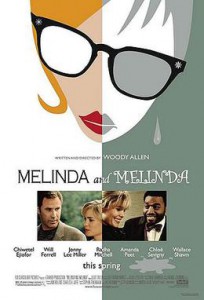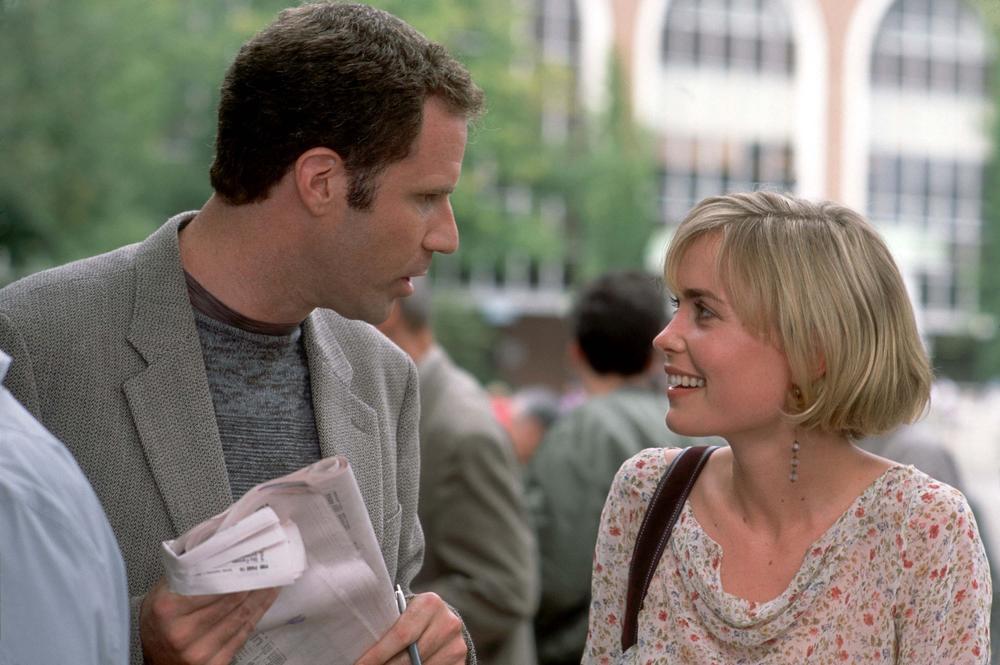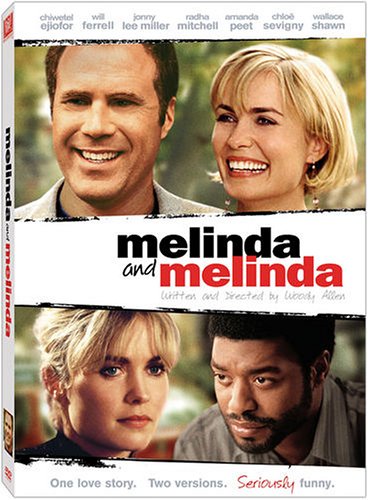This is the pre-edited version of a review published in its post-edited form elsewhere on this web site, as well as in the March 25, 2005 issue of the Chicago Reader. — J.R.
MELINDA AND MELINDA*
DIRECTED AND WRITTEN BY WOODY ALLEN WITH RADHA MITCHELL, WILL FERRELL, CHLOE SEVIGNY, CHIWETEL EJIOFOR, JONNY LEE MILLER, BROOKE SMITH, WALLACE SHAWN, AND LARRY PINE
“Amongst a democratic population, all the intellectual faculties of the workman are directed to…two objects: he strives to invent methods which may enable him not only to work better, but quicker and cheaper; or, if he cannot succeed in that, to diminish the intrinsic quality of the thing he makes, without rendering it wholly unfit for the use for which it is intended. When none but the wealthy had watches, they were almost all very good ones; few are now made which are worth much, but everybody has one in his pocket. Thus the democratic principle not only tends to direct the mind to the useful arts, but it induces the artisan to produce with great rapidity many imperfect commodities, and the consumer to content himself with these commodities.”
— Alexis de Tocqueville, Democracy in America (1835)
De Tocqueville’s 170-year-old account of why Americans often blanch at intellectual abstraction and art-for-art’s-sake — and prefer accessibility over complexity when it comes to both thought and art — still seems pretty up to date. And it accounts for the imperfect commodities one often finds in the cineplexes with uncanny accuracy. Simply to assert that Americans hate to think when they go to movies would be snobbish and unjust, even if some viewers —- and, it would seem, quite a few producers —- arrive at precisely that conclusion. After all, there are many kinds of thinking, and anti-intellectualism doesn’t necessarily translate into a dislike of crossword puzzles or brain teasers. In some cases, it might even be associated with liking them.
Just as some teenagers who claim they hate to read and write enjoy spending hours doing both on the Internet, brain-teaser movies have been enjoying a certain vogue over the past few years among filmgoers who tend to scoff at the very idea of thinking much at movies. One might even regard these movies as closeted substitutes for intellectual and arthouse fare.
It’s a taste that can be traced back to the jigsaw-puzzle narrative construction of Pulp Fiction in 1994, although the trend got started in earnest with Memento in 2000, which took the step of telling a complicated story backwards, and then gained further momentum when the same gimmick got combined with sex and violence in Irreversible two years later. In both of these cases, the simple task of figuring out the story takes so much concentration and brain power that other issues —- such as what the stories mean, whether or not they’re worth telling or thinking about, and whether the characters are significant figures or just disposable pieces of genre machinery —- tend to take on secondary importance.
Arguably, part of the similar appeal of both Eternal Sunshine of the Spotless Mind and Kill Bill, despite their having more substantial characters than either Memento or Irreversible, derives from the challenge of putting all their scrambled narrative pieces together. This ultimately leads to a process with somewhat brutal misanthropic implications whereby the characters, however ample, are still regarded and treated like objects —- like jigsaw pieces or slabs of meat — by filmmakers and viewers alike, as well as by other characters. Among current releases, The Jacket seems to appeal directly to the same taste, and there are undoubtedly other examples that could be cited.
Woody Allen, who makes no bones about his respect for intellectual and arthouse fare, continues to show certain signs of it in Melinda and Melinda, his latest feature. As usual, this has something to do with struggling artists occupying classy apartments in the Upper East Side and the West Village —- what the New York Times’s A.O. Scott aptly terms a kind of pornography involving real estate. But whether Allen’s conscious of it or not, he’s also pitching his wares at the brain-teaser crowd, and this proves to be a lot more consequential than the script’s furnishings — intellectual, artistic, or pornographic — in accounting for what the experience of watching the movie is like.
The slender premise is to tell the same basic story in two alternate styles, one of which it calls “tragic,” the other of which it calls “comic”. The framing device that justifies this simplistic exercise is an argument between playwrights in a downtown bistro, surrounded by a few friends; Sy (Wallace Shawn) maintains that “the essence of life isn’t tragic, it’s comic” and Max (Larry Pine) maintains the opposite. When someone else starts telling an allegedly real-life anecdote about the unexpected crashing of a dinner party by a former college chum named Melinda (Radha Mitchell), Sy and Max each maintains that the story illustrates his point. The remainder of the film oscillates between a tale of abject misery and a romantic comedy, each featuring Melinda with a different set of characters while following variations of the same plot. Eventually, as you might have guessed, it’s concluded that comedy and tragedy aren’t as far apart as the playwrights initially assumed.
It all sounds pretty neat if one doesn’t think about it too much, and overlooks the fact that romantic comedy and abject misery are almost invariably and interchangeably opposite sides of the same coin in the world of Woody Allen. Speaking for myself, I didn’t get much chance to think about it, because keeping up with which story is what took up most of my attention, and the few times I did stop to think about what Sy and Max were saying, I regretted doing so. First of all, I couldn’t buy that two supposedly sophisticated theater people could be that simple-minded about what comedy and tragedy consist of. I also couldn’t believe in most of the characters in either story, including both versions of Melinda. (Notable exceptions are black characters played by Chiwetel Ejiofor in the “tragic” story and Daniel Sunjata in the “comedy”. It’s refreshing to find black characters of any kind in an Allen film, especially unstereotypical ones.)
One form of familiar shorthand employed by Allen to inform us whether or not what we’re watching is supposed to be funny is the use of lively jazz to signal comedy and classical music (often modernist) to signal tragedy. This is simple and obvious enough when it involves snatches of numbers by Erroll Garner (“The Best Things in Life Are Free,” “Will You Still Be Mine?”, “Somebody Stole My Gal”) and Bela Bartok’s “String Quartet No. 4,” though Garner’s signature light-heartedness and Bartok’s signature gloom already smack of facile musical typecasting. When it comes to sound bites from Duke Ellington (“Take the ‘A’ Train,” “In a Mellow Tone,” “I Let a Song Go Out of My Heart”), Igor Stravinsky (“Concerto in D for String Orchestra”), and J. S. Bach (“Partita No. 3, BMV 827,” “Prelude 2, Well Tempered Clavier”), typecasting spills over into caricature, and it’s us as listeners as well as the musical pieces themselves that get short-changed. Bringing on additional portions of the same pieces doesn’t help, either, because Allen basically uses them as if he were turning a faucet off and on.
The way he uses many of his actors is similar, and this can’t help but reflect on the way he views his audience. In these terms, a “tragic” move or detail in the story can feel as much like a sucker punch as a wisecrack uttered by Will Ferrell (Allen’s latest surrogate, in the “comic” segments.) If we’re allowed to stop and think about these characters, our belief in them is likely to be at risk, so Allen works overtime at keeping us busy with other matters.
But these problems are intermittent and ultimately negligible. The point of the movie isn’t really to engage anyone’s belief but to entertain and exercise its own limited premises. It’s like one of those lousy but universal watches de Tocqueville was referring to; it doesn’t tell the time very well, but it keeps on ticking.





